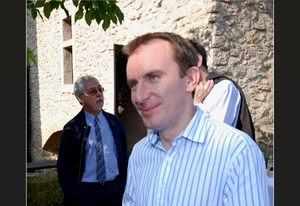HiPER—the other way to fusion energy
There are two ways to achieve fusion on Earth. In "magnetic fusion," strong magnetic fields confine a tenuous plasma inside a vacuum vessel. By way of various heating techniques, this plasma is brought to the temperature at which fusion reactions can occur. This is a path that was chosen half a century ago to pursue industrial production of electricity—magnetic fusion is what ITER and all tokamaks are about.
In inertial confinement fusion (ICF), the fusion fuels are contained in tiny pellets that are compressed by an array of powerful lasers. On impact of the laser beams, the plasma instantly reaches very high density and temperature, fusion reactions occur and, as in magnetic fusion, energy is liberated.
The National Ignition Facility at Lawrence Livermore National Laboratory in Livermore, California, which was completed earlier this year, and the Laser Mégajoule in Bordeaux, France, to be operational by 2016, will demonstrate the production of energy from laser fusion. These facilities have been built in support of the requirements of the nuclear test ban treaty.
The installation to follow these has energy production as its focus. Now half way through its preparation phase, HiPER (the High Power laser Energy Research facility) has a goal to "open a credible route to inertial fusion energy for commercial purposes." HiPER's Executive Board held its fourth meeting last week at the Château de Cadarache.
"I'm convinced that both approaches, magnetic and inertial, will be realized," says Mike Dunne, Director of the UK Central Laser Facility at Rutherford Laboratory and Project Coordinator for HiPER. "Considering the energy challenge, we need as many solutions as we can deliver."
The HiPER project, which was launched in 2005, is now "halfway through preparation phase" and construction could begin in the early years of the coming decade. "For the moment, it's a UK-coordinated, European project. We have 26 institutions from ten different countries in the consortium. The real internationalization is the next phase ..."
One of the challenges HiPER will address is the "high repetition technology"—that is, aligning the nanosecond laser shots and the 1 millimetre diameter pellets five times per second. Something "relatively simple," says Mike Dunne, which should be achieved in the five to seven years to come.
Other challenges are not so different from those of magnetic fusion. "There is a huge amount of overlap with ITER. Because the physics of magnetic and inertial fusion were different, the two communities were separated. Now, they're coming together and we have a lot to gain from collaboration."
At the HiPER meeting last Friday at the Château, the Executive Board included Carlos Alejaldre from ITER, Francis Kovacs from CEA and several personalities from the world of nuclear science. "They are people from outside our field but with an experience with large projects. Their job is to steer us in the right direction to convince the world of the benefits of fusion."



